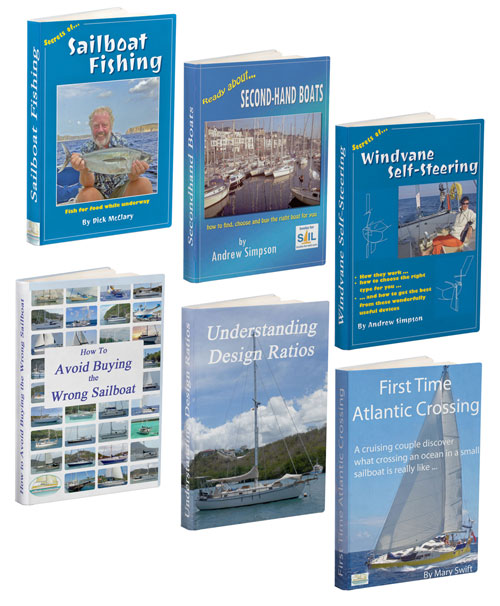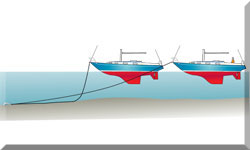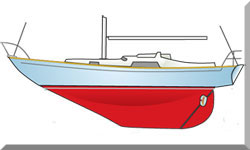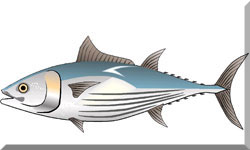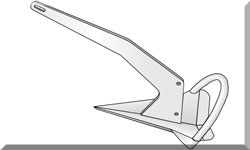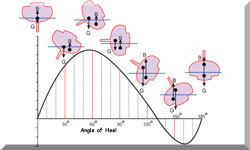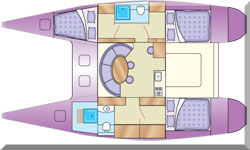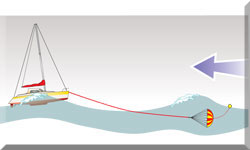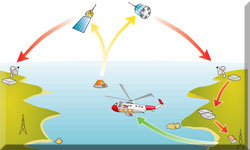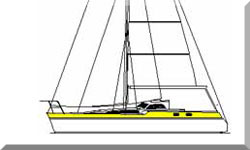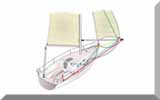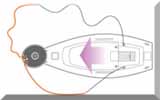- Home
- Electronics & Instrumentation
- Marine Gps Chartplotter
Do You Really Need a
Marine GPS Chartplotter?
As the name might suggest, a marine gps chartplotter is a marriage of electronic chart software and GPS technology combined in a single display.
Marine chart plotters come either in the form of a software package installed on a laptop computer, or a dedicated instrument. Each has its merits, and both rely on an interface with a GPS signal.
The screen is normally larger on a laptop, but some will argue that its vulnerability as a portable device makes it less attractive than a dedicated plotter, most of which are marinised and fully weatherproof.
But if you already have a laptop or a tablet and want to save a few bucks, then the laptop route may well be the way to go - particularly so now that fully functional free chart plotter software can be readily downloaded from the internet - but you won't get the same extensive functionality as you'd get from a bespoke unit.
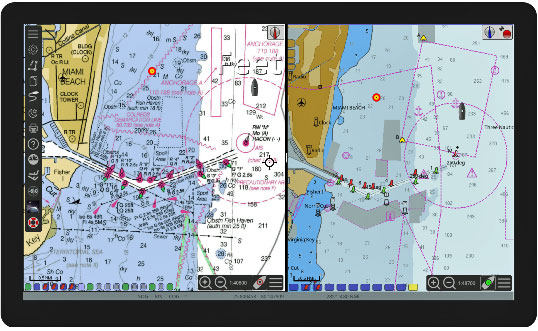 Chart software operating on a tablet
Chart software operating on a tabletA Marine GPS Chartplotter - Luxury or Necessity?
I failed to get excited by marine GPS chartplotters for a long time, preferring paper charts that filled the entire surface of my chart table rather one which only filled a small screen - if I'd thought about it a little longer, perhaps I'd have realised they weren't mutually exclusive.
But while reviewing the options for a new radar installation at the London Boat Show, I was persuaded to play around with a multi-function display unit on a manufacturer's stand.
Not only was it possible to switch between the radar display and the chart plotter display, you could also view them simultaneously in 'split-screen' mode. But what did it for me was the overlay mode.
This enabled the radar display to overlay the chart display, with zooming in and out making it much easier to interpret when close to shore. I didn't stand a chance - it had to be mine.
Installed at the chart table and fully integrated with wind, log and depth instruments my new Raymarine C80 become a very useful aid to both navigation and passage planning, and supplements - not replaces - my paper charts.
But now it's outdated and needs replacing, so I've been researching what current chartplotters have to offer—and this is what I found:
The Modern Chartplotter: Beyond Basic Positioning
Enhanced Situational Awareness
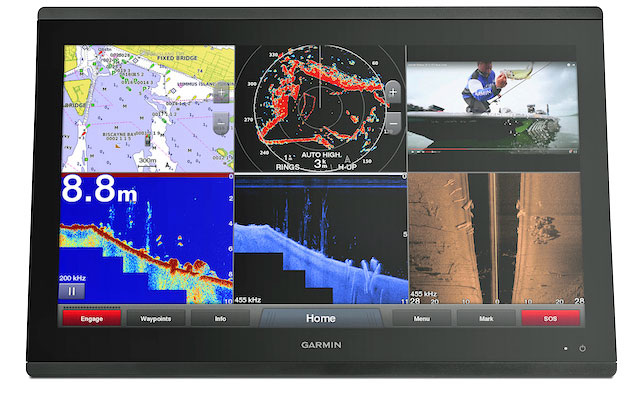 The Garmin GPSMap 8400 MFD, a full-featured high-end chartplotter
The Garmin GPSMap 8400 MFD, a full-featured high-end chartplotterAdvanced Radar Technology
Forget those hazy green radar screens of yesteryear. Today, it's like having a crystal ball showing you everything around. High-def digital radar paints this incredibly detailed picture of the fleet and the coastline.
And get this – Doppler tech can actually color-code moving targets, making potential trouble practically jump out at you in a busy channel. Plus, it’ll intelligently filter out all that annoying wave and rain clutter.
Then there’s MARPA, which just effortlessly tracks multiple contacts, spitting out their course, speed, and how close and when they’ll get to you. Makes scribbling bearings with a pencil feel like ancient history, doesn't it?
Forward-Looking Sonar (FLS)
Then you've got forward-looking sonar. Seriously cool bit of kit. Imagine peering under the waves ahead of your keel in real-time. It paints a picture of the seabed, showing you those sneaky shoals or submerged nasties before you’re right on top of them.
Think about nosing into a poorly charted anchorage or just having that extra peace of mind approaching an unfamiliar coast. It’s almost like giving your hull X-ray vision.
Connectivity & Onboard Integration
Satellite Communication
Venturing offshore? Staying connected used to be a whole thing. Now, many chartplotters just hook into sat comms like Iridium or Inmarsat. Bam – weather updates, emails for logistics or just keeping in touch, even voice calls, all through your MFD.
Picture downloading those detailed GRIB files hundreds of miles out, letting you make smart calls about your route and timing. Talk about a safety and self-sufficiency boost.
Digital Switching and Engine Monitoring
But it's not just about nav and comms. Digital switching is changing how we even manage the boat’s electrics. Instead of a whole bank of individual switches, you can often control lights, pumps, the works, right from the chartplotter screen.
It’s this central, often customizable hub, letting you monitor everything and even set up modes for anchoring or getting ready to leave. And keeping tabs on the engine? Easy.
Modern chartplotters can tap right into your engine data, showing you everything from RPMs to temperature to fuel burn. Some even flag potential mechanical hiccups, letting you get ahead of maintenance and manage fuel better on those long hauls.
Sophisticated Charting & Networking
Enhanced Digital Charts
The charts themselves have gotten seriously smart too. High-res bathymetry gives you this incredible detail of the seabed, sometimes down to just a few feet of contour. Perfect for finding fishy spots, that ideal anchorage, or just picking your way through tricky coastal waters.
And it’s getting better all the time with user-submitted depth data – the collective knowledge of the sailing community right there on your screen. For a real sense of place, some plotters overlay satellite imagery right onto the chart. It's super helpful for picking out shorelines, reefs, all that coastal detail, especially where the regular chart might be a bit vague.
Plus, you can usually tweak what you see – depth soundings, nav aids, tides, currents, even points of interest – creating custom views for different situations, like squeezing into a harbour or dropping the anchor.
Seamless Electronic Integration
Getting all your electronics talking to each other is key these days. Protocols like NMEA 2000 act like a universal translator, letting all your sensors and instruments share info over one simple network. Less spaghetti wiring and everyone’s got the latest data.
For the big stuff, like radar images, Ethernet handles the bandwidth, especially with multiple displays. But the real magic happens when it all works together – the autopilot following a course you drew on the chartplotter, radar targets popping up right on your charts with their AIS info, instrument readings right next to your navigation data.
It just makes everything safer and simpler, giving you a much better feel for your boat and what’s around you.
Software, Mobile Connectivity & Security Considerations
Software Updates & Ecosystems
Like any decent piece of software, your chartplotter’s brain is constantly evolving. Regular updates aren’t just about new bells and whistles; they squash bugs and, crucially, keep your charts bang up-to-date. Staying on top of these is just part of being a responsible skipper.
Big players like Garmin, Raymarine, and B&G have built their own ecosystems of gear and software. While NMEA 2000 helps everyone play nice, sticking within one brand often gives you the slickest integration and unlocks some cool extra features. Think about the range of their gear, how intuitive their stuff is, and what kind of support they offer down the line.
Mobile Apps & Remote Access
And get this – many now have companion mobile apps that let you see and even control some things from your phone or tablet. Imagine planning your next leg in comfort below, then having it sync right to your main unit. Some even let you check instruments or tweak the autopilot remotely. Pretty handy, right?
Cybersecurity Awareness
With all this connectivity, though, we’ve got to think about security. As your boat’s electronics get more networked, there are potential vulnerabilities. Marine cybersecurity isn’t a huge talking point yet, but basic stuff like keeping software updated and being careful with unfamiliar networks can help keep your systems safe.
Making Informed Choices: Key Considerations
Now, all this fancy tech is great, but making smart choices about chartplotters means digging into some fundamentals.
Dedicated Units vs. Software Solutions
First off, dedicated unit versus software on a laptop or tablet. Dedicated units? They’re built for the rough and tumble of the marine world – tough, sunlight-readable, and they play well with other boat gear. Downside? They can hit the wallet harder upfront.
Software on your own devices? Flexible and potentially bigger screen, maybe cheaper to start. But they often lack the ruggedness and sunlight visibility, and getting them to talk to everything else might need extra fiddling.
Essential Features & Integration
Then you’ve got to eyeball the key features.
- Screen size and brightness are huge for seeing things clearly in all sorts of light.
- Touchscreen or buttons? Depends on your style and whether you’re often wrestling with wet hands.
- How fast does it think? Processing power matters, especially if you’re running a bunch of stuff at once.
- What connections does it have? NMEA 2000, Ethernet, Wi-Fi, Bluetooth – make sure it fits your current and future setup.
- And charts – Navionics, C-MAP, Garmin BlueChart, etc. – check the coverage and detail for where you sail and who you prefer.
Also, can it grow with you? Can you easily add more sensors later?
Installation, Power & Usability
Once you’ve picked one, getting it installed and playing nicely with your existing gear can be straightforward or a bit of a puzzle. For bigger or more complex setups, getting a pro involved is often a smart move to avoid headaches and potential damage.
Power draw is another thing to keep in mind, especially if your electrical system is a bit tight. Bigger, brighter screens suck more juice. And a super-powerful plotter is useless if it’s a pain to use. An intuitive interface is gold, especially when things get a bit sporty. Try before you buy, or at least watch some demos.
Safety & Practicalities
Importance of Backup Navigation
Experienced sailors know the drill: backups are non-negotiable. Relying on just one electronic brain for navigation is asking for trouble. Having a second plotter, a tablet with nav software, or even good old paper charts and a compass is just plain smart, especially offshore.
Cost & Maintenance
And let’s talk brass tacks – these things are an investment. Factor in not just the initial cost, but also ongoing chart updates, software subscriptions, and any install fees. Finally, a little TLC goes a long way. Keep the screen clean and protect it from the elements when you can.
Conclusion: Navigating the Future
So, there you have it. Chartplotters have come a long way, offering us incredible tools. By getting a handle on these advancements and thinking through the practicalities, you can confidently navigate the digital age, making your sailing safer, more efficient, and even more enjoyable.
Any chartplotter-related questions? Odds are you'll find all the answers here...
Recent Articles
-
Albin Ballad Sailboat: Specs, Design, & Sailing Characteristics
Jul 09, 25 05:03 PM
Explore the Albin Ballad 30: detailed specs, design, sailing characteristics, and why this Swedish classic is a popular cruiser-racer. -
The Hinckley 48 Sailboat
Jul 09, 25 02:44 PM
Sailing characteristics & performance predictions, pics, specifications, dimensions and those all-important design ratios for the Hinckley 48 sailboat... -
The Hinckley Souwester 42 Sailboat
Jul 09, 25 02:05 PM
Sailing characteristics and performance predictions, pics, specifications, dimensions and those all-important design ratios for the Hinckley Souwester 42 sailboat...
